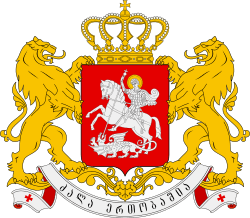Georgian parliamentary election, 2004
 |
| This article is part of a series on the politics and government of Georgia |
|
Legislature |
|
Judiciary |
Legislative elections were held in the Georgia on March 28, 2004. The elections followed the annulment of the November 2003 legislative elections, which were widely believed to have been rigged by the former President, Eduard Shevardnadze. New elections were ordered following the resignation of Shevardnadze and the election of President Mikhail Saakashvili in January 2004.
The elections were won by the National Movement - Democrats (NMD), the party supporting President Mikhail Saakashvili. The NMD won 67% of the vote, while no other party won more than 7.6%.
As a result, the NMD won most of the 130 seats elected by proportional representation in the Georgian Parliament. Of the 20 parties contesting the elections, only the NMD and the Right Opposition bloc polled more than 7% of the vote, the threshold necessary to gain representation.
Results
| Parties and alliances | Votes | % | Seats |
|---|---|---|---|
| National Movement – Democrats (Nats'ionaluri Modzraoba – Demokratebi, ერთიანი ნაციონალური მოძრაობა) | 1,027,070 | 67.0 | 135 |
Rightist Opposition (Memarjvene Opozits'ia, მემარჯვენე ოპოზიცია)
|
116,282 | 7.6 | 15 |
| Democratic Union for Revival (Demokratiuli Aghordzinebis kavshiri, დემოკრატიული აღორძინების პავშირი) | 6.0 | - | |
| Georgian Labour Party (Sakartvelos Leiboristuli Partia, საქართველოს ლეიბორისტული პარტია) | 5.8 | - | |
| Freedom Movement (Tavisupleba, თავისუფლება) | 4.2 | - | |
National Democratic Alliance (Erovnul Demokratiuli Aliansi)
|
2.5 | - | |
Jumber Patiashvili – Unity
|
2.4 | - | |
| Members elected in single-seat constituencies (November 2003) | 75 | ||
| members representing displaced persons from the separatist region of Abkhazia | 10 | ||
| Total | 1,518,751 | 235 | |
| Source: German Wikipedia and Civil.ge. | |||
These voting figures come from German Wikipedia and Civil.ge.
The new Georgian Parliament will also include 85 members elected from single-member constituencies, who were elected in the November 2003 elections and have not been required to face re-election. The exact party loyalty of these members is not known, but Georgian websites suggest that about 23 of them are NMD members or supporters, about 15 are opposition supporters, and the rest are independents.
The National Movement - Democrats party unites President Saakashvili's National Movement, Prime-Minister Zurab Zhvania's United Democrats, the Republican Party, supporters of Parliamentary Chairperson Nino Burjanadze and some of the supporters of the late President Zviad Gamsakhurdia, the Union of National Forces.
The Right Opposition is a center-right pro-business alliance led by David Gamkrelidze.
At a press conference, Saakashvili said: "I think the people have given their verdict. I am not pleased that there is not more opposition representation, because that would have helped my party too to consolidate. But that is the reality, the post-revolutionary reality."
A preliminary report by observers from the Organization for Security and Co-operation in Europe (OSCE) praised the conduct of the elections.
"The 28 March 2004 repeat parliamentary election in Georgia demonstrated commendable progress in relation to previous elections. The Georgian authorities have seized the opportunity, since the 4 January presidential election, to further bring Georgia's election process in closer alignment with European standards for democratic elections, including OSCE commitments and Council of Europe standards," the report said.
"However, in the wake of the events of November 2003, the political life of Georgia, as reflected in the election process, is not yet fully normalized. The consolidation of the democratic election process will only be fully tested in a more competitive environment, once a genuine level of political pluralism is re-established."
In an attempt to produce an election result acceptable to both domestic and international opinion, the Georgian government allowed the votes to be counted simultaneously by the CEC and by a non-government organisation, the International Society for Fair Elections and Society (ISFED). This was called the parallel vote tabulation (PVT). Figures released by ISFED on March 31 showed results almost identical to those released by the CEC.
